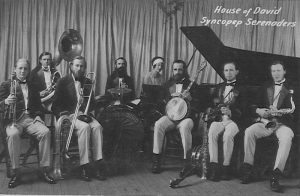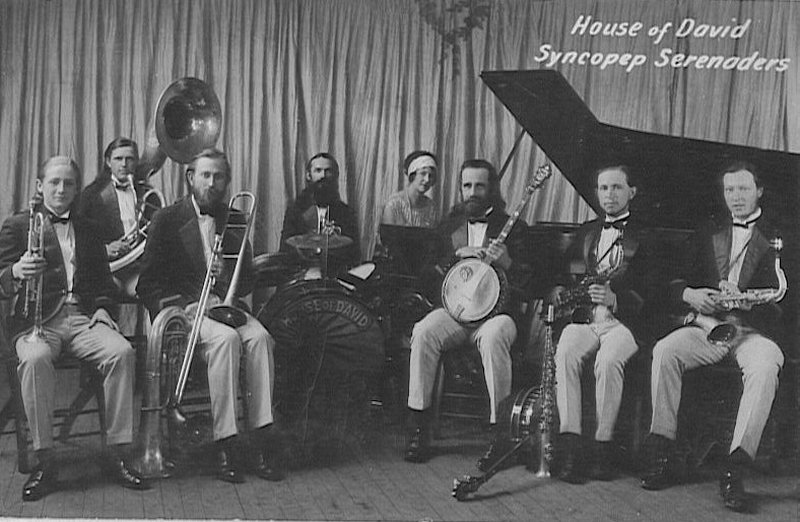
• Geoffrey C. Ward and Ken Burns: Jazz — A History of America’s Music, Knopf, 2000.
• Ken Burns’ Jazz — The Story of America’s Music, Legacy, 2000
BROADCAST on PBS in January, Ken Burns’ Jazz was a massive undertaking. Attempting to chronicle the music from its inception, the documentary included vintage film clips, audio, photos and interviews covering hundreds of musicians. An accompanying book, a five-disc box set, and 22 individual artist CD compilations completed the package. There was much to be impressed with; jazz CD sales have even seen an increase over the last month.
For all the positives (and there were many), the series has some serious shortcomings. It ignores some sub-genres, including Latin and Western Swing. Others — specifically Avant Garde and Fusion — are depicted as failures; while they might not be for every taste, both deserve a more even-handed critique. (As musician Bix Beiderbecke once said regarding a player he didn’t enjoy: ‘Well, just because I ain’t receiving, don’t mean he ain’t sending!’)
For the most part, we’re told what is worthy, and what isn’t — with little room for dissenting views. In order to reinforce arguments, Roland Kirk is reduced to a mad-as-hell protester, Nat King Cole is used to illustrate the deep south’s racist leanings, and Charles Lloyd is portrayed as a rock wanna-be, throwing in the towel after failing to attain stardom.
Louis Armstrong and Duke Ellington receive ample amounts of screen time, whereas Charles Mingus and Thelonious Monk are allotted less coverage than deserved. Ethel Waters gets a small feature, but there’s no mention of Bing Crosby — a far greater influence on jazz vocalizing. Albert Ayler, Sun Ra and other less mainstream figures are barely mentioned. Weather Report, a key fusion group which influenced a generation of players, is not even mentioned in the video (one track appears on the CD box set).
In the final episode, Wynton Marsalis makes a rather bewildering statement — claiming that the prime motivation for all jazz greats, from Louis Armstrong to Miles Davis was to “[give] us a glimpse into what America is going to be when it becomes itself. And this music tells you that it will become itself.” Jazz may have originated in the United States, but it can’t be confined by national boundaries. As far as being ‘America’s music,’ where does that leave Joe Zawinul (Austria), Django Reinhardt (Belgium), Perez Prado (Cuba), Kai Winding (Denmark), Stephane Grappelli (France), Andre Previn (Germany), Gabor Szabo (Hungary), Sadao Watanabe (Japan), Vido Musso (Sicily), and Victor Feldman, George Shearing, Marian McPartland, and John McLaughlin (all from England)? Canada has contributed Gil Evans, Oscar Peterson, Paul Bley, Maynard Ferguson, and Georgie Auld, to name five.
These gripes aside, there is much in the series to be impressed with; it’s encouraging to see the music get such exposure.
• Ian Carr: Miles Davis: The Definitive Biography, Harper Collins, 1998.
One of the 20th century’s most influential musicians, Miles Davis was full of contradictions: he was, at times, profane, and possessed a violent temper; but his music reveals a rare depth and sensitivity that transcends everyday circumstances.
Throughout his career, he continually reinvented himself. From beginnings with Charlie Parker and be-bop — a contentious form that split audiences (Louis Armstrong dubbed it a “modern malice”) — through his work with arranger Gil Evans, the legendary quintets, to almost single-handedly creating the fusion movement with Bitches Brew, his work was always fresh and forward-looking.
At more than 600 pages, Carr covers all the significant eras, and the pace rarely lets up. First published in 1982, this updated edition almost doubles the length of the original — and remains one of the finest chronicles of a remarkable life.
• Brian Glasser: In a Silent Way — A Portrait of Joe Zawinul, Sanctuary Publishing, 2001
Joe Zawinul is one of the most creative players to emerge in the last 40 years. Glasser — with Zawinul’s blessings –retraces his childhood in pre-war Austria. Thanks to perfect pitch, he was moved to the Vienna Conservatory at seven years old. When the Allies stepped up bombing raids, a small group of students were transferred to a palace in Czech Sudetenland. Zawinul explains: “They wanted the most talented young musicians to be safe for the victory of the German Reich.” The palace was stocked with Bosendorfer pianos. When the Russians took over, the piano lids were torn off; the instruments were filled with hay, and used to feed soldier’s horses.
After the war, Zawinul was exposed to jazz on the American G.I. radio network. Inspired by the music, he moved to the United States in 1959, on a scholarship from Berklee Music School. A few weeks into the first semester, he dropped out in order to take a gig with big band leader Maynard Ferguson — followed, a year later, by a stint as an accompanist for Dinah Washington.
In 1961, he became a member of the Cannonball Adderley Quintet, for whom he wrote ‘Mercy, Mercy, Mercy’ in 1967. Incorporating a gospel feel with a soulful jazz groove, the song was a major pop hit — scoring a Grammy, and going on to become a modern standard. During the late 60s, he wrote and recorded a number of pieces with Miles Davis — including the title track from In A Silent Way. In 1971, Zawinul formed Weather Report with saxophonist Wayne Shorter. One of the most imaginative and successful acts in the fusion genre, the group remained a top draw throughout its 14-year history.
Drummers were always first rate, including Alex Acuna — who exited shortly after recording the group’s breakthrough album, Heavy Weather. In an illuminating interview, he explains: “My departure from the band didn’t have to do with anything about the music, or playing with Weather Report. It had to do with my family. For me, God is first; second is my wife and children; and third is the music.”
Acuna is one of the busiest session players in the business, working with U2, Frank Sinatra, and a host of others. His perspective is refreshing: “My father used to tell me that everyone is just people, that they all have to go to the bathroom; so for me, it was never such a big thing to play with Elvis Presley, Diana Ross, Weather Report. The only big thing for me is my Lord Jesus Christ.”
• Lewis A. Erenberg: Swingin’ The Dream, University of Chicago Press, 1999
Swingin’ The Dream covers the golden age of the Big Bands, with emphasis on the social and political implications. While the ‘60s-era baby boomers are generally perceived as the generation that changed the world, Erenberg offers solid arguments that the swing era experienced a cultural revolution just as dynamic. In addition to rejecting the stodgy middle class ethos, big bands broke the colour line a full decade before baseball and the military. The music was embraced by critics and the public, dominating radio airplay and the sales charts — the only time jazz was perceived as a potent sales force.
Erenberg examines reasons for the music’s demise as a commercial force, and the subsequent arrival of be-bop. Many bop players converted to Islam — in part, due to the absence of a colour line. Dizzy Gillespie, who would eventually embrace Bahai, is quoted explaining that Islam “brings people together . . . But Christians . . . don’t allow black people in the church, even. What kind of religion is that? . . . Don’t say I’m forsaking Christianity, because Christianity is forsaking me.” Fascinating — and, for those interested in the sociological impact of the era, a must read.
• Blutopia, by Graham Lock (Duke University Press) 1999
Blutopia explores three renowned jazzmen’s views of the African-American experience — specifically, as it relates to racism, the future, and music criticism. Lock examines how Duke Ellington, Sun Ra and Anthony Braxton used their music to fight the status quo; and each had a singular spiritual approach.
Ellington, a Christian, co-opted the language of his faith, portraying a heavenly reward for suffering on earth. Braxton claimed that music has the power to “heal deserts and create planets.” Sun Ra concentrated on cosmology, and held a fascinating (if wildly unorthodox) world view — claiming that he was born on another planet; it’s hardly a surprise when Lock acknowledges that, during his first interview with Ra, he had “no idea what he was talking about.”
Through copious research, and a willingness to look at issues in context — however bizarre — all three individuals are afforded a great deal of respect. A serious study that looks well beyond the eccentricities, Blutopia is a remarkable book.
• Martin Taylor with David Mead: Kiss and Tell – Autobiography of a Traveling Musician, Sanctuary Publishing, 2000
British guitarist Martin Taylor’s career as a first-rate sideman includes stints with violinist Stephane Grappelli (they recorded 20 albums together), Teresa Brewer, David Grisman, Chet Atkins, Bill Wyman, and a host of others. His autobiography, presented in an anecdotal, conversational manner, makes for an enjoyable look at a fascinating, unpretentious life on the road, from English Holiday camps to Carnegie Hall.
• Stuart Nicholson: Jazz Rock – A History, Schirmer Books, 1998
Combining rock sensibility with jazz improvisation, jazz rock (a.k.a. fusion) experienced its peak — both creatively, and in sales — during the 1970s. Miles Davis’ Bitches Brew (1969) was the watershed release, with the bulk of acts to follow — including John McLaughlin’s Mahavishnu Orchestra, Weather Report, Chick Corea’s Return To Forever, Herbie Hancock’s Headhunters and Tony Williams Lifetime — all led by Davis alumni.
In its heyday, the music included a conscious spiritual element uncommon in other genres. McLaughlin (along with Carlos Santana) followed Indian guru Sri Chimnoy; Corea, and Return to Forever bassist Stanley Clarke, were Scientologists; Hancock was into Buddhism; Weather Report’s Alex Acuna and Chester Thompson were Christians. The new sound influenced a few more adventurous big bands — those of Woody Herman, Stan Kenton and Maynard Ferguson; each incorporated elements of the music, and younger brass-based acts like Blood, Sweat & Tears, Lighthouse, Chase and Chicago hit the pop charts.
Initially an exciting change which proved that jazz need not be left behind, the music delivered a much needed shot –- or shock — in the arm. After a couple of good years, however, things got more predictable. The music moved to more extremes: either self-indulgent chop fests, or smooth jazz. For the most part, the architects moved on — or back, in most cases, to earlier and more traditional forms.
Nicholson’s book is a welcome chronicle of a much-maligned genre — the last movement in jazz to really excite its audience.
• Scott Yanow: Swing, Miller/Freeman, 2000
• Scott Yanow: Bebop, Miller/Freeman, 2000
Well researched, with enough information to keep anyone — from the neophyte to the long time-listener — interested, Yanow’s books include bios on all significant players. On top of the obvious entries, ample coverage is given to sidemen, arrangers and composers; Yanow also includes film appearances, and recommends biographies. In addtion to the glory years and subsequent revivals, Swing includes generous coverage of today’s neo-swing movement. Both books make for worthy additions to any jazz library.
© John Cody 2001
